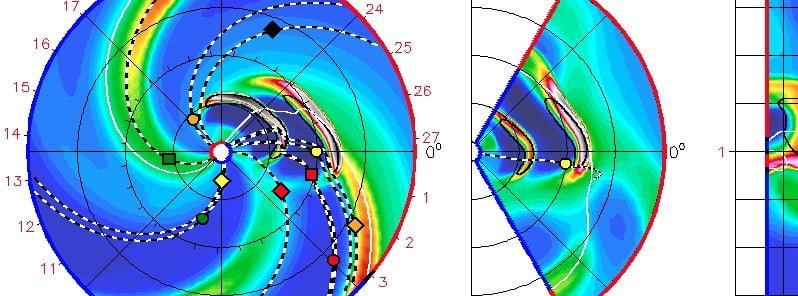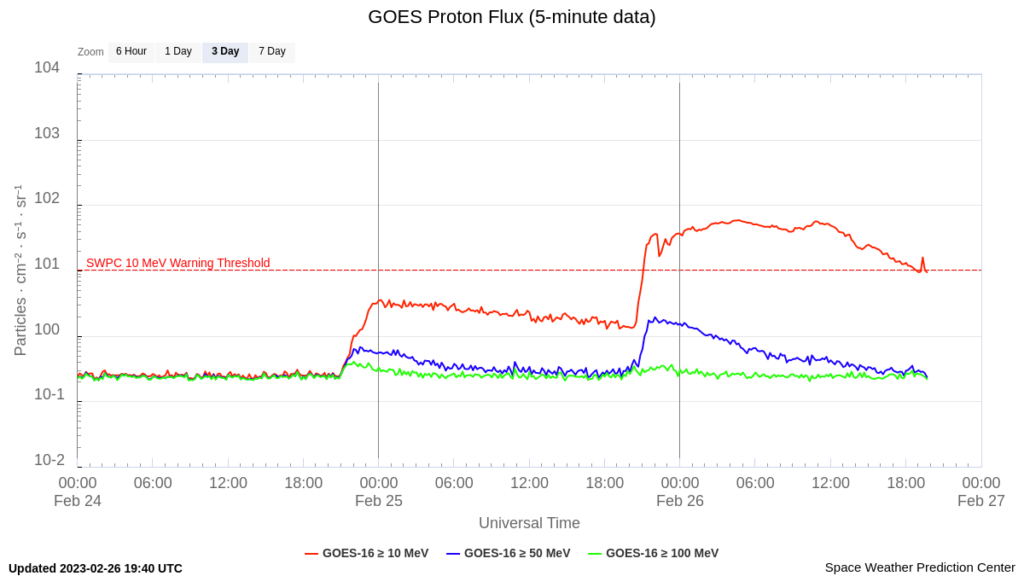CME impacts Earth, sparking G3 – Strong geomagnetic storm

Coronal mass ejection (CME) produced by a long-duration M3.7 solar flare at 20:30 UTC on February 24, 2023, reached Earth at 19:25 UTC on February 26.
- The impact of this event is anticipated to be followed by a glancing blow from another CME generated by the M6.3 solar flare on February 25, expected to arrive during the afternoon hours on February 27.
- The resulting geomagnetic storm activity is expected to be significant due to both CMEs interacting with a negative-polarity coronal hole high-speed stream (CH HSS).
- This interaction has the potential to produce G3 – Strong or even higher levels of geomagnetic storm activity.
The partial-halo CME associated with the M3.7 flare from Region 3229 was determined to have an Earth-directed component and the Enlil model analysis correctly suggested an arrival time late on February 26.
In addition, analysis of an asymmetric halo CME, associated with a long-duration M6.3 flare at 19:44 UTC on February 25, suggests a glancing blow impact on February 27.
Both CMEs are expected to interact with a negative-polarity CH HSS, potentially producing significant geomagnetic storming.
As a result, a couple of hours before the arrival of the first CME, SWPC issued a G3 – Strong geomagnetic storm watch for February 27 and G2 – Moderate for February 28.
Potential impacts
The area of impact is primarily poleward of 50 degrees Geomagnetic Latitude.
Induced currents – Power system voltage irregularities are possible, and false alarms may be triggered on some protection devices.
Spacecraft – Systems may experience surface charging; increased drag on low Earth-orbit satellites and orientation problems may occur.
Navigation – Intermittent satellite navigation (GPS) problems, including loss-of-lock and increased range error, may occur.
Radio – HF (high frequency) radio may be intermittent.
Aurora – Aurora may be seen as low as Pennsylvania to Iowa to Oregon.
Solar Proton Event
Our planet is still under the influence of the S1 – Minor Solar Radiation storm that started after the M6.3 flare on February 25, but the effects are now waning and expected to drop below the S1 threshold soon.


Update
The Geomagnetic K-index of 7 (G3 – Strong geomagnetic storm) threshold was reached at 08:00 and 11:15 UTC.
Vivid auroras were seen in both hemispheres:
February 28
12:40 UTC
It is currently unclear and there is still some uncertainty, however, general consensus at this time is that both anticipated CMEs have arrived at Earth, SWPC forecasters said at 12:30 UTC today. Therefore, combined CME passage is likely to continue but weaken on February 28.
Also, Earth is under the influence of a CH HSS and even as transient passage weakens, the solar wind field will likely remain disturbed.
If the additional CME from February 25 is still transiting space, we would likely see an additional enhancement in the solar wind environment on February 28, although other solar wind field indicators are not showing signs of another looming arrival at this time.
Featured image credit: SWPC



Commenting rules and guidelines
We value the thoughts and opinions of our readers and welcome healthy discussions on our website. In order to maintain a respectful and positive community, we ask that all commenters follow these rules.